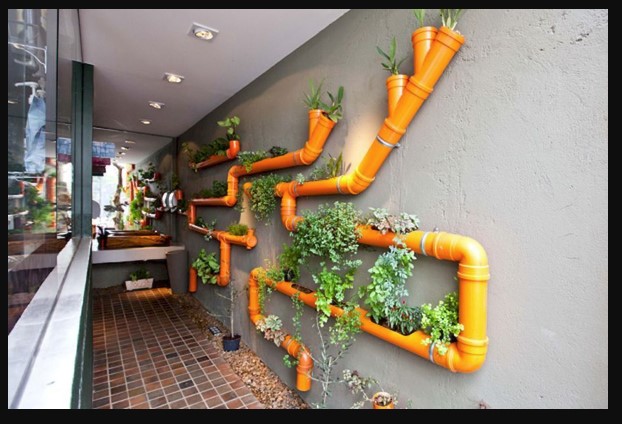Introduction
Vertical gardening is a revolutionary approach to gardening that uses vertical space to grow plants, herbs, vegetables, and flowers. This innovative method is especially useful for those with limited horizontal space, such as urban dwellers with small yards or balconies or indoor gardening enthusiasts.
This article will delve into vertical gardening, its benefits, techniques, and how to start your vertical garden.
Understanding Vertical Gardening
Definition of Vertical Gardening
Vertical gardening involves cultivating plants on a vertically suspended panel using hydroponics, soil-based methods, or a combination of both. It transforms unused vertical spaces into lush, green areas and can be implemented indoors and outdoors.
History and Evolution
The concept of vertical gardening is not entirely new. Ancient civilizations like the Babylonians practiced a form of vertical gardening with the Hanging Gardens of Babylon, one of the Seven Wonders of the Ancient World. Modern vertical gardening, however, has gained popularity due to urbanization and the increasing need for sustainable living practices in compact spaces.
Benefits of Vertical Gardening
Space Efficiency
One of the most significant advantages of vertical gardening is its ability to save space. Growing plants vertically allows gardeners to maximize their available area, making it an ideal solution for small apartments, patios, and balconies.
Improved Aesthetics
Vertical gardens can transform dull walls or fences into beautiful, vibrant green spaces. They enhance the visual appeal of both indoor and outdoor environments and can serve as living art pieces.
Better Air Quality
Plants are natural air purifiers. Vertical gardens can improve air quality by absorbing pollutants and releasing oxygen, making the surrounding environment healthier and more pleasant.
Enhanced Plant Health
Elevating plants off the ground can reduce the risk of soil-borne diseases and pests. Vertical gardening can promote better air circulation around plants, leading to healthier growth and higher yields.
Water Efficiency
Many vertical gardening systems are designed to be water-efficient, using drip irrigation or other methods to minimize water waste. This makes vertical gardening eco-friendly, especially in regions with limited water resources.
Techniques and Systems for Vertical Gardening
Wall-Mounted Planters
Wall-mounted planters are among the most common vertical gardening systems. These can be made from various materials, including plastic, metal, and fabric pockets. They are ideal for growing small plants, herbs, and flowers.
Trellises and Arbors
Trellises and arbors support climbing plants like ivy, beans, and peas. Made from wood, metal, or plastic, they are perfect for adding greenery to fences and walls.
Vertical Garden Towers
Vertical garden towers are freestanding structures that allow plants to grow in a columnar arrangement. These towers can accommodate various plants, from herbs to vegetables, and are suitable for indoor and outdoor use.
Hydroponic Vertical Systems
Hydroponic vertical systems grow plants using nutrient-rich water instead of soil. These systems are highly efficient and can produce higher yields than traditional soil-based methods. They are ideal for growing leafy greens, herbs, and other fast-growing plants.
Pallet Gardens
Recycled wooden pallets can be repurposed into vertical gardens. Pallet gardens are affordable and versatile, allowing gardeners to grow plants in a compact space. They are trendy for growing herbs and small vegetables.
Getting Started with Vertical Gardening
Choosing the Right Location
Select a location that receives adequate sunlight for the plants you intend to grow. Most vegetables and herbs require at least 6 hours of sunlight per day. If gardening indoors, consider using grow lights to supplement natural light.
Selecting Suitable Plants
Choose plants that are well-suited for vertical growth. Herbs, leafy greens, and small vegetables like cherry tomatoes and peppers are excellent choices for vertical gardens. Additionally, consider your area’s climate and growing conditions when selecting plants.
Preparing the Structure
Please set up your chosen vertical gardening system, ensuring it is securely anchored and can support the weight of the plants. If using a wall-mounted system, ensure it is properly installed to prevent damage to the wall.
Planting and Maintenance
- Soil and Fertilizers: To ensure healthy plant growth, use high-quality soil and organic fertilizers. Regularly check the soil moisture levels and water the plants as needed.
- Pruning and Training: Regularly prune and train your plants to encourage vertical growth and prevent overcrowding.
- Pest Control: Monitor your vertical garden for pests and diseases. Use organic pest control methods to maintain a healthy garden.
FAQs About Vertical Gardening
What types of plants are best for vertical gardening?
Herbs, leafy greens, small vegetables, and climbing plants best suit vertical gardening. Examples include basil, spinach, cherry tomatoes, cucumbers, and peas.
Can vertical gardens be grown indoors?
Yes, vertical gardens can be grown indoors with adequate lighting. If necessary, use grow lights to supplement natural light, and choose plants that thrive in indoor conditions.
How often should I water my vertical garden?
Watering frequency depends on the plant species, climate, and the type of vertical gardening system used. Generally, vertical gardens require more frequent watering due to faster drying. Check the moisture levels regularly and water as needed.
Is vertical gardening expensive?
The cost of vertical gardening varies depending on the system and materials used. DIY options like pallet gardens are affordable, while hydroponic systems can be more expensive. However, the long-term benefits and potential savings on groceries can offset the initial investment.
What are the common challenges of vertical gardening?
Common challenges include ensuring adequate sunlight, managing water and nutrient distribution, and preventing pests and diseases. Proper planning and regular maintenance can help overcome these challenges.
Conclusion
Vertical gardening offers a sustainable and space-efficient way to grow plants, making it an excellent choice for urban dwellers and gardening enthusiasts.
By understanding the techniques and benefits of vertical gardening, you can create a thriving green space that enhances your living environment and contributes to your well-being.


